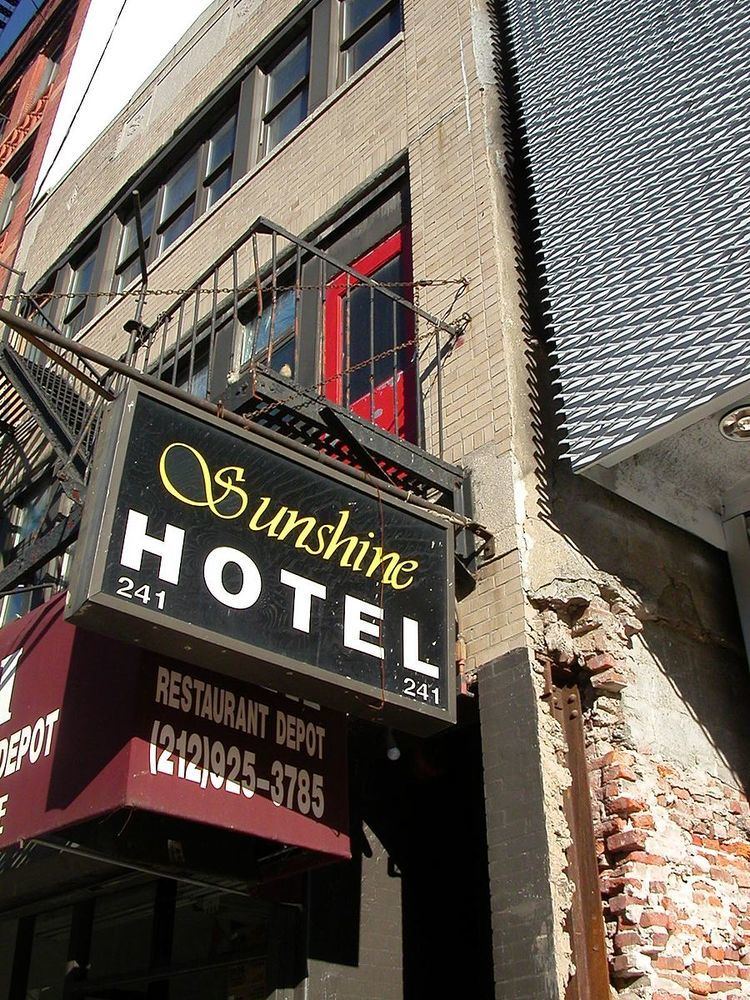 | ||
The Sunshine Hotel is a flophouse established in the 1920s located at 241 Bowery in Manhattan, New York City. It received media attention in the late 1990s and early 2000s as a result of numerous radio and film documentaries about the hotel. The Sunshine Hotel has shrunk in more recent years, with some parts being converted into a restaurant and offices.
Contents
Description
Upon establishing the hotel in the 1920s, Frank Mazzara reworked the façade in the styles of Art Deco and Commercial. This façade has pale yellow bricks, limestone pediments and panels, and plaques with wreath and torch emblems. 241 Bowery is three stories high and is connected internally to its neighbors 243 and 245 Bowery.
The Sunshine Hotel had a three-building structure with sections labeled Lakewood, Sunshine, and Annex. The Lakewood had 45 rooms, the Sunshine had 100, and the Annex had 36. Each cubicle room offers no amenities except a bed, a locker, a light-bulb, and chicken-wire ceiling. These rooms' dimensions are 4 ft × 6 ft (1.2 m × 1.8 m) on the sides and 7 ft (2.1 m) tall. When the hotel opened in the 1920s, guests could stay for 10 cents (equivalent to $1.43 in 2016) a night. By 1998, its rates were $10 a night.
History
The address 241 Bowery was originally an office for the New York and Harlem Rail Company in the 1830s. In the late 1870s it was the location of the saloon and brothel Sultan Divin, and in 1910 the Fleabag saloon took over. By the early 1920s, the address was an old pickle factory. The broom-maker Frank Mazzara bought the location in 1922 and established the Sunshine Hotel.
Mazarra's son Carl started running the Sunshine Hotel in 1946. In 1949, the New York branch of the NAACP investigated Bowery hotels and found that the Sunshine Hotel was discriminating against black people by refusing them service. In 1970 James Adair, the hotel manager at the time, refused to sell cigarettes to a man and was then shot to death on the hotel's second floor. Carl retired in 1984 and sold the hotel to the Bari family, which used part of the hotel to store their business's pizza ovens.
By 1998, the Sunshine Hotel accommodated about 125 residents. The flophouse received attention during this time after being featured in an NPR segment created by David Isay. Nathan Smith, the narrator of the segment and 16-year manager of the Sunshine Hotel, died of cancer in 2002.
In August 2004 Anton Bari, the owner of the Sunshine Hotel, started buying out residents and denying new guests from checking in. During this time, the flophouse had about 44 guests.
By 2008, the Sunshine Hotel had less than 30 residents. On June 30, 2008, the New York City Department of Housing Preservation and Development ruled that the hotel's employees were harassing tenants to force them out. The city government gave the hotel three more years before developers could use the location.
The Sunshine Hotel lost its plywood signage in 2011 as workers converted the first floor of one of the hotel's three buildings into the Bowery Diner. In August 2014, Roseann Carone of Harlen Sales started converting the building's two upper floors into offices. Meanwhile, the 30 to 40 Sunshine Hotel residents stayed in neighboring 239 Bowery.
Radio
David Isay and Stacy Abramson spent a year creating an All Things Considered segment on the Sunshine Hotel which aired on September 18, 1998. Isay edited 70 hours of raw tape to less than half an hour. Isay and Abramson then collaborated with photographer Harvey Wang to write a book about life in various Bowery flophouses, including the Sunshine Hotel.
The program won a Prix Italia award in 1999 under the factual documentary category. The documentary was included in an episode of the radio show 99% Invisible which aired on August 4, 2015.
Miles Maguire compared the documentary's narrative to Dante's Inferno, where the hotel manager Nathan Smith takes the role of Virgil as tour guide and narrator; and the guests represent various personality disorders.
2000 film
Phil Bertelsen created a 30-minute documentary film titled The Sunshine in 2000 which follows some residents and workers for the Sunshine Hotel. It won awards for best short documentary at the 2000 Woodstock Film Festival and at the 2000 Shorts International Film Festival. Bertelsen was given the prize for "Best African-American Student Filmmaker" at the 2002 DGA East Coast Student Film Awards for his work on this film.
2001 film
The filmmaker Michael Dominic heard David Isay's NPR segment and became interested in the making a documentary about the flophouse. Released in 2001, it was his first documentary. It was released on DVD in 2012.
Andrea Chase praised the film's cinematography and structure, writing that the film "offers a unsparing look at what it means to hit bottom and stay there." Josh Ralke also gave the film a positive review, praising how it captures the lives of the hotel's residents.
Art
Around July 2004, the artist Julianne Swartz created an art installation titled "Can You Hear Me?" that used a yellow PVC tube to connect the second floor of the Sunshine Hotel to a platform on the sidewalk. The tube had mirrors which pedestrians could look through and interact with Sunshine Hotel residents. This project was part of an exhibition designed to explore the diversity of the Bowery and was done in anticipation of the future opening of the New Museum. Sunshine Hotel residents had mixed feelings regarding the project; some enjoyed the interactions with outsiders while others were uninterested.
On August 19, 2016, the Philadelphia songwriters Sam Cook-Parrott and Michael Cantor released the album The Afterglows with the first track titled "Angels In The Sunshine Hotel". This song was inspired by the story of a man who moved to New York to study philosophy, but who ultimately went broke and became a Sunshine Hotel tenant.
